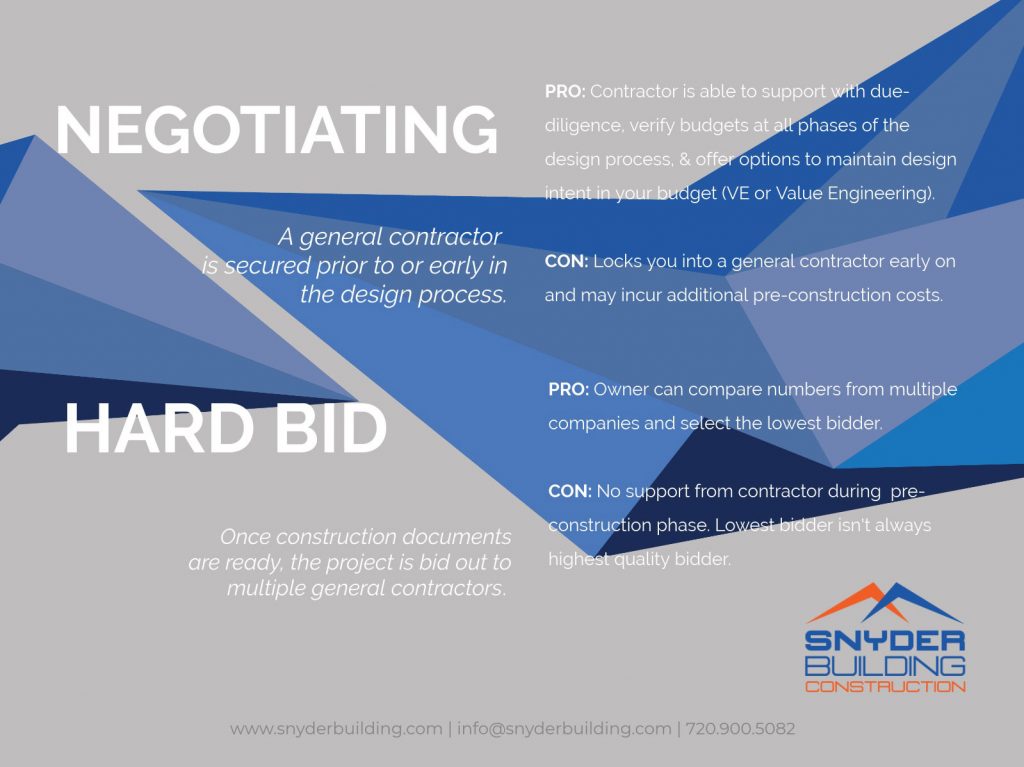Bars, Restaurants, and Breweries, Oh my! Part II: Designing for Efficiency and Budget
A Three-Part Construction Series
February 26, 2018
collaboration by: Matt Redick & Audrey Wilson
Our first segment ran through the nuts and bolts of building a restaurant and highlighted four areas of focus: the place, the people, the budget, and the schedule. As you saw, restaurants, bars, and breweries are tough work! In Part II, we’ll explore efficiencies in mechanical, electrical, and plumbing design while considering budget, tricks of the trade, and avoiding pitfalls.
Before we jump in, it’s important to highlight there are dozens of types of eateries out there, and we’ve certainly built the gamut. Still, the food service business is constantly changing. We recently heard the CEO of Quizno’s share that there’s a growing trend towards a new market segment, QSR “minus” which includes spaces as small as 500SF for the simple purpose of pickup and delivery only. Clearly a venture of that size requires different considerations than a 100,000 SF market hall.
Some of the most common types of eateries are:
- Fast Casual
- QSR +/-
- Casual & Family Dining
- Local & Chef-Driven
- Fine Dining
- Brewery
- Bar
- Gastro/Brew Pub
- Fast Food
- Central Market Halls & Eateries
- Food Trucks
When you’re designing the layout of the restaurant and kitchen with your design and construction team, the type of eatery you plan on building plays heavily into cost and design considerations. From there, space planning, project costs and critical budget efficiencies are ultimately determined by the complexity of the menu and existing conditions. You’ll want to answer some big questions at this early stage based on level of service, kitchen and/or dining area flow, and menu. Some of these questions might include:
- What overall project goals are most important for you to achieve? These could include project cost/staying within a particular budget, project duration including design, permitting, construction, and startup/training, sustainability of FFE (Fixtures, Furnishings and Equipment), and efficient use of space for service/work flow?
- How is food prepared, and what equipment will be necessary to create your menu items?
- Is the kitchen an open concept (i.e. visible to guests)?
- How big do you need the walk-in cooler to be? Will some food items be frozen creating the need for walk in freezer space or reach in freezers?
- How many beer taps will you have? Will you need a remote beer cooler? How far do the beer lines have to go if the cooler is remote? Will the lines be run overhead or underground?
- Will you offer temperature controlled wine?
- What food needs to be prepped? Do you need a separate area for this or can you use the kitchen space during off hours? What large or powered equipment will be used for prep?
- Do bakery elements need to be separate for humidity reasons?
- What kind of storage will you need for dry goods, smallwares, pots/pans, etc. Do you require any special storage areas – empty keg storage, wood for wood burning stoves?
- Where is the cook line and how large does it need to be? How will it be organized for efficiency for the typical crew size on a shift? Do you want a consultant for this?
- How will you take deliveries for food products, beer, soda, and dry goods?
- What is the path of travel for deliveries, employees, and FOH/BOH service?
- Can we leave certain MEP (Mechanical, Electrical, Plumbing) systems where they already exist to save money? What existing conditions can you take advantage of? (i.e. leaving bathroom plumbing in the same location, etc.)
- Is there specialty coffee service? Where will you store coffee beans and back-up dairy? Is there a separate dishwasher for coffee service?
- Where are clean dishes stored and dried versus dirties washed? How are tables bused?
- Where is food expedited out of the kitchen?
- Point of Sale Computer Stations – Are they hardwired or wireless? Permanent stations or handheld? How many are required for your size of wait staff, and where will they be located?
- What level of internet service will you need based on your point of sale selections?
- Does your city have a gender-neutral single stall ordinance?
- Do existing conditions require building upgrades for ADA code compliance? In many municipalities, depending on the size and cost of the upgrades you may be required to spend a certain percentage of your budget on ADA upgrades.
- Franchise vs. Owner-Operated – If you’re building a franchise, the franchise may supply you with sample budgets and construction requirements based on historical data.
Michael Racette of WB Engineers+Consultants has designed many commercial kitchens and notes, “During the design and value engineering process sometimes the comfort of the employees is left out of the conversation. Think about working over a hot stove without conditioned air or proper air flow!” Additionally, he says “Don’t forget about designing enough room for water heaters and electrical panels.” These important service areas contain equipment that takes up valuable space, and must be considered when planning for efficient kitchen spaces.
We’d have to agree! Considering comfort for your employees and having a plan for your equipment can prevent running into design issues later on. Having these things planned out ahead of time prevents costly additions after you open your restaurant which is both expensive and a hassle. Can you imagine adding an entirely new electrical panel after the fact? This could require a larger electrical room which in turn means moving or adding walls, relocating equipment, bringing in more electrical service capacity, etc. This is a time consuming and incredibly expensive change.
When designing your restaurant’s layout, a good rule of thumb is that the kitchen’s footprint should generally only be as big as 1/3 of the front of house dining space. This rule of thumb prioritizes dining area so that you are able to have more people in seats spending money. Typically this means developing creative strategies for tight kitchens. Of course, this rule of thumb shifts or changes based on the type of eatery you are building. If you are pick-up only, you won’t need to worry about space for a dining area.
We mentioned this in the last post as well, but setting your complete equipment package early is critical. The equipment package drives the mechanical, electrical, and plumbing design. In this day and age, some equipment companies have the ability to design in a program called Revit which produces 3D models of your space. Many architects do the same. Working with a team that uses Revit is a great advantage to you because you are able to see in 3D how your space will look. The design team can also use Revit to identify potential conflicts between lighting, HVAC ductwork, and sprinkler heads to prevent these problems from arising during construction. Take it even further by using Google Glasses to take a 3D virtual reality (VR) walk through the space. VR is a great new tool that allows you to more easily think through service/kitchen operation issues before any drawings are finalized or equipment is purchased. What a time and money saver!
Considerations for Building with Budget in Mind
In the construction world, there are two main ways to get started with general contractors. The two main methods of getting your contractor on board are Hard Bid and Negotiating and there are pros and cons of each delivery system.
Hard Bid
The Owner engages an architect and design team, but does not engage a contractor during this pre-construction phase. Once the construction documents are ready, the project is bid out to multiple general contractors to create a competitive bidding situation. Each contractor submits a bid based on what has been designed by the design team.
- Pros: Because competitive bids are being submitted, the Owner can compare numbers from multiple companies and select the lowest qualified bid.
- Cons: No support from a general contractor during the pre-construction phase. The lowest bidder isn’t always the highest quality builder. No opportunity to value engineer the project before it starts.
Negotiating
A general contractor is secured prior to or early in the design process who can then support you and the design team through pre-construction. The general contractor contributes a construction perspective as design decisions are made to ensure that choices are in line with the overall construction budget. The general contractor assists with permitting and planning the schedule for the project prior to the start of construction.
- Pros: Our pre-construction services include surveying/due-diligence of the building, verifying budgets along the way at 50%, 90%, and 100% complete design. We help you navigate design and provide strategic options for maintaining the intent of the design while getting the most bang for your buck (VE or Value Engineering). We can test your design and budget to make sure your construction project is viable in the location/market to begin with and work your broker on negotiating tenant improvement money from the building owner/landlord. When negotiating, we still send the project out to bid with multiple subcontractors for each scope of work for the best competitive pricing.
- Cons: Additional pre-construction service costs with the general contractor.
If your project is a franchise, both hard bid and negotiating options may be available for you. At the very least, you want a local general contractor to verify your budget to make sure the construction budget is viable in your particular location and market.

A Few Words About Used vs. New vs. Leased Equipment. When getting ready to purchase equipment, think about life cycle of the piece. There are pros and cons to each of these options. Often more sustainable choices such as LED lighting may cost more upfront, but may be a long-term investment that pays off. Used equipment, while less expensive up front and easy to obtain, costs more to deliver, maintain, and install than something new. It may require repairs or retrofits to make it work in your particular situation. It usually takes more of your time when you purchase used equipment to navigate and organize installation of the various parts and pieces. New equipment has the advantage of being new, better up-to-date technology, a product warranty, easier installation, and included delivery. New equipment can, however, cost a lot more and may have a longer lead time which may be prohibitive to the project schedule. Leased equipment can be a helpful strategy for specific pieces of equipment due to regular up keep and maintenance. For example, commercial kitchen dishwashers require soap refills and periodic upkeep. Leasing the dishwasher then alleviates your need to keep up with it. The leasing company will take care of refills and maintenance for you. The downside is that by renting the equipment, you’re not benefitting from the capital investment and you will find not all the equipment you need is available to lease.
In the end, due diligence, operational clarity, and planning will create the opportunities for time and cost savings. Thinking critically and asking big questions related to operations and maintenance will serve you well in designing MEP systems that work well and fall in line with your budget.
Bonus! Bonus! Food trucks! Believe it or not, simple food trucks still require MEP and health code inspections just like a restaurant. While this process certainly doesn’t take quite as long, keep in mind equipment and systems and layout matter! As a minimum, you’ll need an approved hand sink, grey water system, and sturdy electrical.
Want more information on building a QSR, Fast Casual, Fine Dining or other type of restaurant? Email info@snyderbuilding.com or call us at 720.900.5082.

Recent Comments